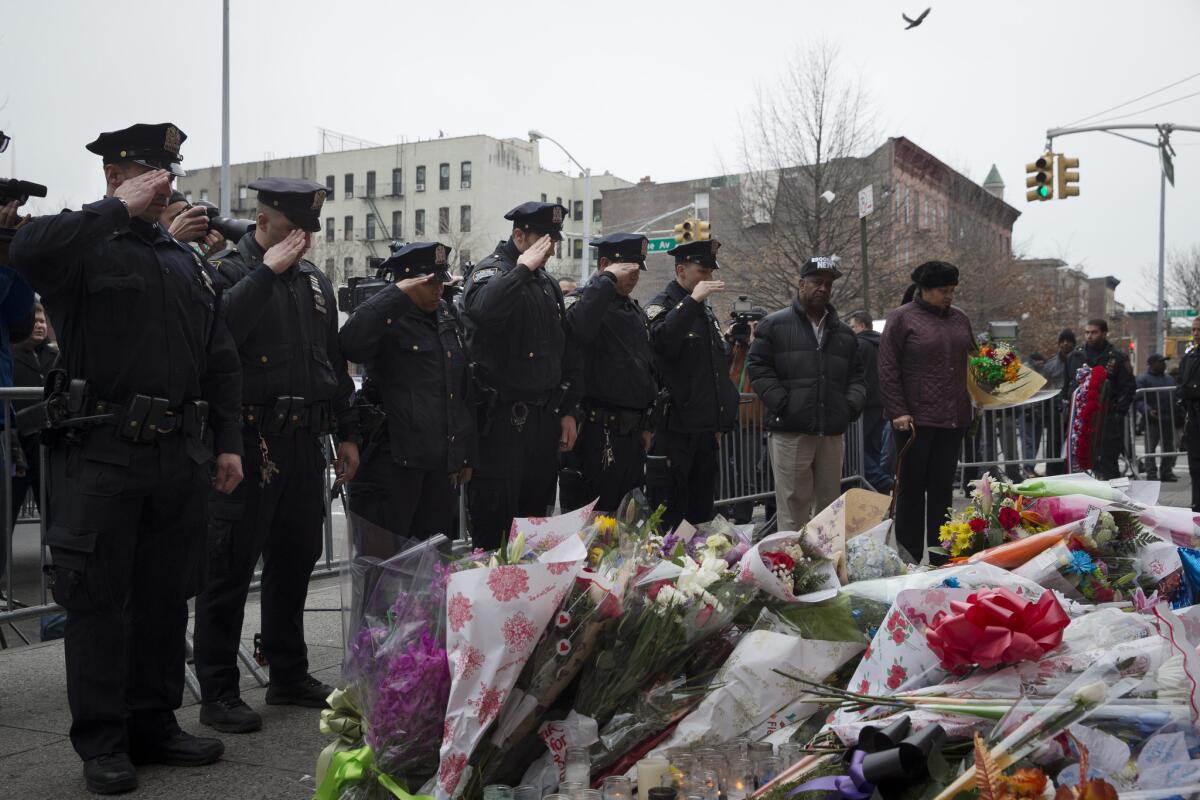Ambushes of police are rising again at a difficult time for law enforcement

Fellow officers salute before a makeshift memorial near the site where New York City police Officers Rafael Ramos and Wenjian Liu were ambushed and killed in Brooklyn in December 2014.
- Share via
Reporting from Washington — The number of ambushes of police officers has been creeping back up in recent years, creating concern among law enforcement officials at a time when relations between police and the communities they serve are particularly fraught.
The number of surprise assaults on police rose to about 250 incidents per year between 2008 and 2013, up from about 200 per year during the previous 10-year period, according to a Justice Department study released Tuesday. Those figures were still far lower than in the 1990s, when ambushes peaked one year above 500.
NEWSLETTER: Get the day’s top headlines from Times Editor Davan Maharaj >>
The recent uptick has concerned officials. “In an era of strained community relations and struggles with police legitimacy, violence against police is of particular concern,” said Ronald L. Davis, director of community-oriented policing at the Justice Department.
Police departments in urban areas have come under new scrutiny over their use of force against young black men since the shooting death of Michael Brown in Ferguson, Mo., in August 2014.
FBI Director James B. Comey said in a speech last week that police officers may be responding to concerns of being video-recorded by being less aggressive, allowing violent crime to increase. The White House and others quickly discounted that assessment.
The report found a direct correlation between violent crime and ambushes against police, which it defined loosely as both premeditated traps and spontaneous but unexpected attacks. It described ambushes as assaults on police that are executed by surprise, from a position of concealment, and with overwhelming force.
But to the embarrassment of the Justice Department, which has been heavily advocating community-oriented policing, the study also found a small statistical correlation suggesting that the number of ambushes was higher in places with a greater level of community-oriented policing activities.
It called the finding “confounding,” but asserted that “it is not within the realm of any plausible theory that community-oriented policing is a contributing factor to violence against the police.” Rather, it said, the correlation may be due to incomplete data or the fact that such policing techniques tend to be applied in communities where violence is already high.
Factors that lowered the risk of police ambushes were higher education levels among police recruits and the use of cameras mounted on police cars, which provide a deterrent on both officer and citizen behavior, the report said.
While the ambushes cited in the report included both fatal and non-fatal incidents, Davis expressed particular concern about the fatalities.
“We know that the murder of a police officer in the line of duty is an assault on the entire community. However, when that murder is a result of an ambush, it also attacks the very foundation of our democracy,” he said.
Twitter: @timphelpsLAT
Hoy: Léa esta historia en español
ALSO
Girl in Vietnam War napalm photo gets laser treatments in U.S. to heal her scars
Video shows South Carolina school officer tossing student across classroom floor
Air Force’s plan for new stealth bomber could bring thousands of jobs to the Southland
More to Read
Sign up for Essential California
The most important California stories and recommendations in your inbox every morning.
You may occasionally receive promotional content from the Los Angeles Times.











